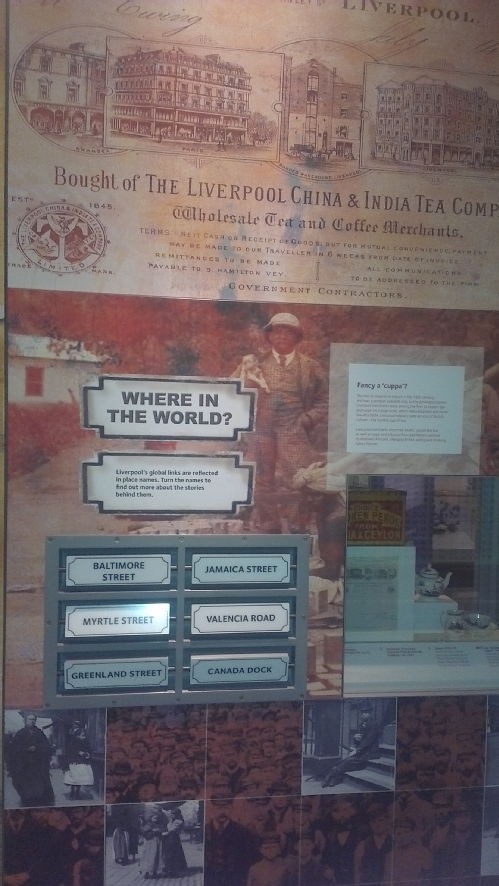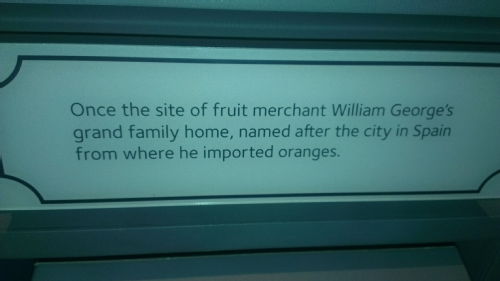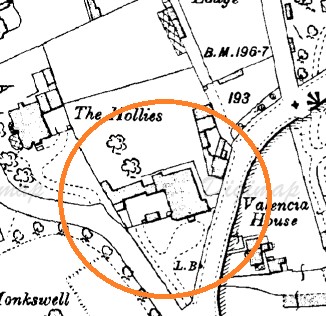Valencia House, Liverpool

Valencia Road in Wavertree, laid out by 1938 when it appears in Kelly's Liverpool Directory, is one of just a handful of concrete reminders of Liverpool's historic Hispanic connections. Its history is even part of the Museum of Liverpool's Global City Gallery, where it is included in the 'Where in the World?' display (right) alongside other references to Liverpool's global trading past, in Baltimore, Myrtle, Greenland and Jamaica Streets and the Canada Dock. Liverpool's connection with the Mediterranean port city of Valencia , on Spain's south-east coast, came through the fruit trade, as Liverpool merchants and brokers imported oranges, raisins, figs and other fruits grown on Valencia's fertile estates.
, on Spain's south-east coast, came through the fruit trade, as Liverpool merchants and brokers imported oranges, raisins, figs and other fruits grown on Valencia's fertile estates.

The museum's display is interactive - if you spin the 'Valencia Road' sign, you find a short explanation of Valencia Road's origins (left), which reads:
Once the site of fruit merchant William George's grand family home, named after the city in Spain from where he imported oranges.
But what do we know about that 'grand family home'? Read on to find out more...
From Hill House to Valencia House...
 In the fork between North Drive and Mill Lane in Wavertree, now the site of a pair of tidy semis, there once stood a large, symmetrical house with soaring chimneys, fine full-length windows, and an elegant stone parapet
In the fork between North Drive and Mill Lane in Wavertree, now the site of a pair of tidy semis, there once stood a large, symmetrical house with soaring chimneys, fine full-length windows, and an elegant stone parapet . Known as Hill House, censuses show it as home successively to the iron merchant Thomas James (1871, 1881) and the fruit merchant Joseph Revill (1891). But the house was put up for rent during 1899, and on the 1908 Ordnance Survey map (right) it has a new name: Valencia House.
. Known as Hill House, censuses show it as home successively to the iron merchant Thomas James (1871, 1881) and the fruit merchant Joseph Revill (1891). But the house was put up for rent during 1899, and on the 1908 Ordnance Survey map (right) it has a new name: Valencia House.
The new name came with the house's new owner: William A[lexander] McGeorge (52), recorded on the 1911 census as a Liverpool-born fruit broker sharing the house's eleven rooms with his Irish-born wife E[dith] M[arie] McGeorge, nee Bivion (40) and two female servants, Mary O'Hare (19) and Lizzie Thomas (15). It is possible that the couple had lived in the property as early as 1901; their address on the 1901 census is given as '3 Mill Lane, Wavertree,' which may well be Valencia House, even if the enumerator didn't note the name.
William McGeorge's connection with Liverpool's fruit trade went back many years. He was the younger brother of Thomas James McGeorge, who lived at Woolton House, on Woolton Hill Road. Thomas was a founding partner of the fruit brokering company McGeorge & Jardine which had been trading in apples, oranges and other fruit since forming from an earlier firm, Connolly, McGeorge & Jardine, in 1884 (Liverpool Mercury, 1 Aug 1884: 8). When Thomas retired in 1912, William continued the firm alongside his nephew TL McGeorge and William C Jardine (London Gazette, 9 Jul. 1912: 5030).
The house was very large. The rental advert published in the Liverpool Mercury in 1899 (which may be when the McGeorges took it over) describes it as
HILL HOUSE, Mill-lane, Wavertree. Detached House; three reception and nine bed rooms, ground floor kitchens, &c., stablings, &c., large gardens and conservatories; rent £120 (Liverpool Mercury, 24 Oct. 1899: 3).
During 1916 and 1917, the occupiers (it isn't clear whether this was still the McGeorges) advertised in the local newspapers for an experienced gardener who was also 'ineligible' [for War Service], giving the address as 'Valencia House, Olive Mount' or 'Valencia House, Mill Lane' (Liverpool Echo, 24/26 May 1916: 1; 27/28 Mar. 1917: 4).
From Valencia House to Valencia Road
Valencia House's new name appears to have stuck even after the McGeorge family left. Chippendale1924, in a post to the Wavertree Memories message board in 2006 , remembered being the 'very last family' to live there from 1927, by which time the property was divided into three households. Their memories of the gardens show just how extensive the property was:
, remembered being the 'very last family' to live there from 1927, by which time the property was divided into three households. Their memories of the gardens show just how extensive the property was:
The gardens were typical of the Victorian ‘landed gentry’, with a two-part 40ft. long greenhouse, one part for grapes and a variety of smaller exotic fruits and the other for Tomatoes. There was a chicken run and a rabbit hut, rabbit was then a more popular dish than now, also quite inexpensive to feed the staff, and an orchard with both pears and apples.
There was also a herb garden including blackcurrants and raspberries, a flower garden, and a vegetable patch, and resplendent in a corner shaded from the north winds, a fig tree, green figs are quite enjoyable, a spacious lawn and a tennis court.
The house was later demolished and its grounds given over to build Valencia Road. Who knows, perhaps some of the current residents are lucky enough to have, in their gardens, a surviving pear, apple or fig tree from Valencia House's long-lost orchard.
Sources
Plan of Valencia House ©Crown Copyright and Landmark Information Group Limited (2015). All rights reserved. (1908).
